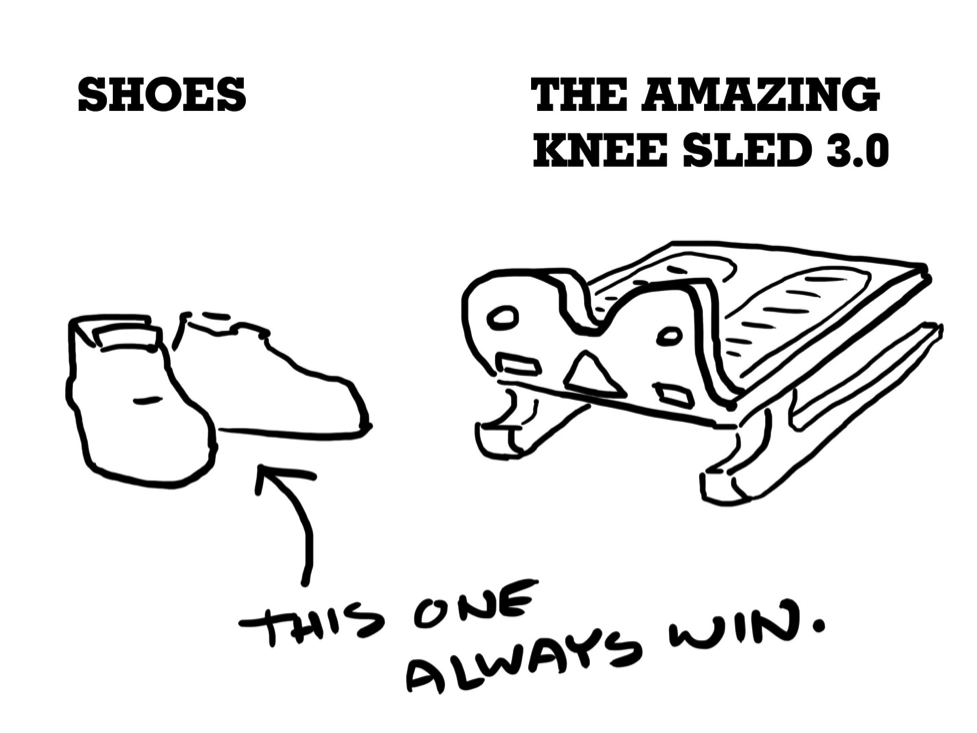What are the success strategies for robot startups? Hardware startups have specific issues to navigate, but the underlying question for innovative startups goes beyond the how-tos, how to build it in the first place and how to not lose money on manufacturing. Robot startups need to ask why this robot? And what is the market? At the HRI2012 conference in Boston, Rodney Brooks said that roboticists need to move beyond solving technical problems and start solving real world problems. “The question isn’t what CAN robots do? The question is what SHOULD robots do?”
This reminds me of a guest post “The Five Secret Laws of Startups” by Fake Grimlock on Extreme Startups. Fake Grimlock is an extremely smart giant robot dinosaur currently terrorizing the startup community. If you haven’t been eaten, then the First law is “Be Shoes”, which intersects with the Third law, “Build things people want” in a very relevant way for robotics. And for those too impatient to go to Extreme Startups right away, the other secret laws of startups were; be awesome at one thing, fight for the user and be contagious. [image below by Fake Grimlock]
“Be shoes” means that crazy new technology is just not useful and “build things people want” is about validating your assumptions in the marketplace, not just building a crazy knee sled because you want one. There’s a lot of amazing knee sled building in the robotics world. That’s not a bad thing for research. But if you want to build a successful robot startup, then amazing knee sleds have got a very very small market. It might change the world one day but only research labs and very early adopters are interested right now. And they are likely to be building their own.
To “be shoes” as a robot startup, you can use lean startup methodology to find out what robot shoes would look like, before investing everything in production. One of these weird shoes was built by a company who knew their market segment very well.
Robots might be new but people haven’t changed much. A successful robot startup is unlikely to be a solo endeavor. Lean startups can benefit from a team approach, to question assumptions and give scope for rapid prototyping, customer development and deep domain knowledge. Eric Ries describes a lean startups as being born out of;
- the use of open source software and free platforms
- agile development methodology
- rapid customer-centric iteration
Successful startups are rarely new products in new markets. Robot shoes improve an existing product. Successful robot startups will resegment existing markets. To a certain extent the robot part of a successful robot startup will and ought to disappear. iRobot’s Roomba is the most successful consumer robot in the world but to most people it’s just a vacuum cleaner. Intuitive’s surgical system augments the doctor. Every toy aisle in the US has disconcertingly lively dolls and toys but very few are called robots.
At the recent Maker Startup Weekend, Dale Dougherty talked about the importance of creating physical products that people wanted. [article by Ahmed Siddiqui] Dougherty pointed out that people pay for physical products all the time, a point sometimes overlooked when cataloguing the difficulties of hardware startups. People pay a lot more for physical objects that are aesthetically satisfying as well. You can want things that you don’t really need.
Two other opportunities for robotics startups are robots as interfaces or translators; and robots as copiers or creators. Examples; robots that convert scientific or mechanical instrumentation or sensors into accessible easy to operate or understand forms, like humanoid robots do; or robots that reproduce something useful, like a 3d printer does.
However, the robot we love the most is the completely new product for a new market. The crazy amazing knee sled 4.0 that flies. There have been very few leaps into the big blue ocean. But the technology used to be a lot more expensive and a lot less common than it is becoming now. The democratization of technology is well demonstrated by the DIY drones movement.
As Chris Anderson from Wired and DIY Drones explains, a few years ago autonomous air vehicles cost hundreds of thousands of dollars and there were only a handful. As more are made, the technology gets cheaper. As the technology gets cheaper, more are made. This takes drones out of the rarified military and industrial air and into the hands of the hobbyist, small businesses and consumers.
Robot startups will flourish as stealth technologies, re segmenting markets and making better shoes. But as we become more familiar with new robotic capabilities, as robots cross the chasm under the guise of toys, hobbies and domestic appliances, robots will launch new markets as new products. We just don’t know what yet. Imagine what startups will happen when every second kid on the street has access to a drone!
Robot Launch Pad is a community interested in exploring robot startups from a lean customer centric perspective. We’re involved in a lot of great events in Silicon Valley. This is just the start of the discussion about robot startups and it’s taking off!
So, be startup robot shoes – kind of like Go Go Gadget shoes, only MORE AWESOME.




WHY BUILD THING NORMAL PERSON WANT?
BECAUSE MOST PEOPLE NORMAL.
MAYBE THAT BORING. BE FAILURE EVEN MORE BORING.
LITTLE BORING NOW FOR SUPER RICH GENIUS ROCKSTAR LATER IS DECENT TRADE.
I agree. Most good robots will be boring. Erin Rapacki has posted about that at IEEE Spectrum: http://spectrum.ieee.org/automaton/robotics/industrial-robots/robots-are-boring.